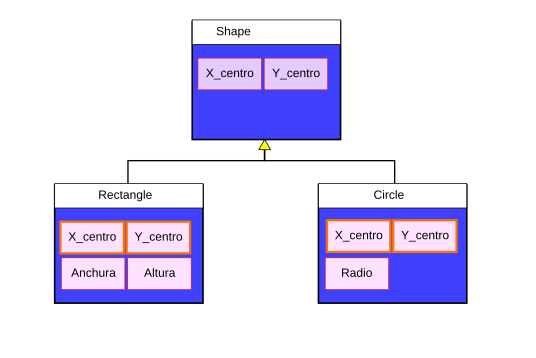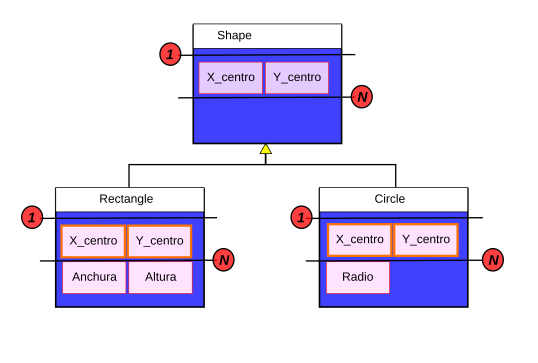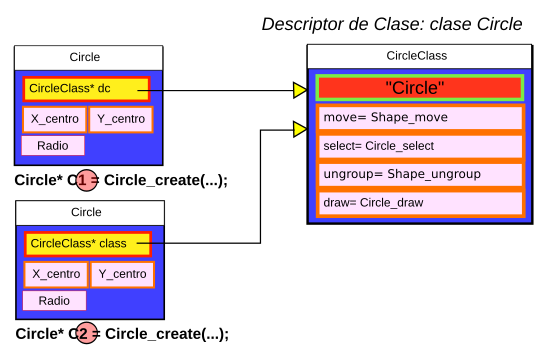TEMA 11: POO y lenguajes no OO.
Programación-II, Universidad de Alicante, 2024-25
Created: 2025-04-30 mié 01:04
¿Es necesario un LOO para hacer POO?
- La utilización del paradigma de programación orientada a objetos requiere cierta disciplina por parte del programador y elementos sintácticos por parte del lenguaje empleado.
- Con los lenguajes no orientados a objetos (LNOO) esto último no lo tenemos disponible pero aún así, sí que es posible hacer POO con un LNOO.
- No vamos a disponer de los elementos que convierten a un lenguaje de programación en un LOO, pero sí que vamos a poder simularlos de manera bastante efectiva.
- En este tema explicaremos cómo hacerlo en el lenguaje C.
¿Qué podemos simular?
- Representación de clases.
- Paso de mensajes.
- Constructores y destructor de una clase.
- Representación de la herencia simple.
- Resolución de métodos en tiempo de ejecución.
¿Cómo es posible hacerlo?
- Dado que trabajaremos en C, vamos a aprovechar la gestión de punteros y la reserva de memoria dinámica de que dispone.
- Esto permitirá que la simulación de las características antes comentadas se lleve a cabo con poca o nula pérdida de eficiencia.
- De hecho veremos ejemplos reales que emplean esta técnica.
Representación de clases
- Empleamos aquello que más se le parece:
struct - De manera que cada clase del diseño se convierte en un
structdel lenguaje. - Cada atributo (datos) definido en la clase es un campo del
structcreado.
- Los objetos serán instancias de estos
structy podrán estar ubicados en el almacenamiento global, en la pila o en memoria dinámica (preferiblemente en este último). - Por lo tanto la referencia a un objeto se puede representar
mediante un puntero a su
struct.
Ejemplo de una clase en C
typedef float Length;
struct Window {
Length xmin;
Length ymin;
Length xmax;
Length ymax;
}
...
struct Window* w;
...
Lenght x1 = w->xmin; /* Mejor emplear setters/getters */
Paso de mensajes
- Debemos seguir un convenio para nombrar a las funciones de manera
que las identifiquemos con métodos de una clase:
NombreClase_nombreMetodo. - En el caso de constructor y destructor emplearemos:
NombreClase_createy en el del destructorNombreClase_destroy.
- Cada método de instancia recibirá un primer parámetro, lo llamaremos self, que representará al objeto receptor del mensaje. Hemos de hacerlo de manera explícita.
- El tipo de este parámetro será puntero a la clase receptora del mensaje.
Un ejemplo de la signatura de un método
/*************************/
/* Clase: Window */
/* Metodo: addToSelected */
/*************************/
Window_addToSelected (struct Window* self, struct Shape* s);
- El paso de parámetros lo hacemos por puntero ya que es más eficiente.
- Como en cualquier función, tenemos accesibles sus parámetros para realizar cualquier operación que queramos con ellos.
Constructores y destructor de una clase
/* Objetos en memoria dinamica */
struct Window* Window_create(Length x, Length y, Length w, Length h) {
struct Window* ventana;
ventana = (struct Window*) malloc(sizeof(struct Window));
ventana -> xmin = x;
ventana -> ymin = y;
ventana -> xmax = x + w;
ventana -> ymax = y + h;
return ventana;
}
void Window_destroy (struct Window* self) {
if (self != NULL) free (self);
}
Representación de la herencia simple.
Preliminares
La simulación de la herencia simple se basa en una idea muy sencilla:
Colocamos al principio de la clase derivada los atributos heredados de la clase base y en el mismo orden en el que están en la clase base.
Esto se puede simplificar si los agrupamos en un struct.
- Añadimos a continuación la parte específica de la clase derivada, es decir, los atributos nuevos que añade la clase derivada.
- Veamos un ejemplo:
Simulando la herencia simple

Simulando la herencia simple

Descriptores de clase
- Para que esta simulación sea completa y podamos añadir posteriormente los métodos a la clase, necesitamos añadir un campo más a cada una de las struct anteriores. Lo añadiremos al principio.
- Se trata de un puntero a su descriptor de clase. Se llamará dc.
- Los descriptores de clase son otro tipo de struct que incluyen a los métodos y variables de clase.
- Por tanto el gráfico anterior quedaría así:

Descriptores de clase
- Utilizando esta técnica podemos pasar un puntero a un objeto de clase Rectangulo o Circulo a una función que espere un puntero a un objeto de tipo Figura.
- Así conseguimos que entre dos clases relacionadas por herencia, la representación en memoria de sus primeros N-bytes sea igual. Esta es la base de la representación de la relación Es Un (Is A) que hay entre una clase derivada y su base.
En el siguiente ejemplo un puntero a un Rectangulo se interpreta como un puntero a una Figura:
struct Rectangle* r; struct Window* w; /* prototipo de: Window_addToSelected */ void Window_addToSelected (struct Window* self, struct Shape* s); ... Window_addToSelected (w, r);
Resolución dinámica de métodos
- Se trata de elegir en tiempo de ejecución qué método invocar en respuesta a un mismo mensaje enviado a distintos objetos.
- En lenguaje C vamos a emplear punteros a funciones para realizarlo.
- Para implementarlo de forma sencilla vamos a hacer uso del descriptor de clase comentado anteriormente.
- El descriptor de clase es una estructura que contiene:
- Una cadena con el nombre de la clase que representa.
- Un puntero a cada método de la clase, incluídos los heredados.
- Las variables de clase que pueda tener la clase a la que representa.
- Los descriptores de clase sólo son necesarios para aquellas clases que vayan a tener instancias y no para clases abstractas tales como `Figura'.
- El nombre de la estructura que representa al descriptor de clase es el mismo que el de la clase añadiéndole el sufijo Class: ShapeClass, CircleClass, etc…
- Veamos un ejemplo de descriptores de clase:
/**********************************/
/* Descriptor de clase para Shape */
/**********************************/
struct ShapeClass {
char* classname;
void (*move) ();
Boolean (*selected)();
void (*ungroup) ();
void (*draw) ();
};
/* Descriptor de clase para Circle */ /* Descriptor de clase para Rectangle */
struct CircleClass { struct RectangleClass {
char* classname; char* classname;
void (*move) (); void (*move) ();
Boolean (*selected) (); Boolean (*selected)();
void (*ungroup) (); void (*ungroup) ();
void (*draw) (); void (*draw) ();
}; };
- La estructura del descriptor de clase define los nombres de las operaciones visibles de la clase y, si existen, contendrá las variables de clase de la clase a la que representa.
- Todavía tenemos que definir e iniciar un objeto descriptor de clase para cada clase.
- Cada uno de estos objetos descriptores de clase es una única variable global, la cual será la única instancia de la clase descriptor de clase correspondiente.
- Cada campo del objeto descriptor de clase debe ser iniciado con el nombre de la función de C (su dirección) definida o heredada por la clase, por ejemplo:
struct RectangleClass RectangleClass = {
"Rectangle",
Shape_move, /* void (*move) () */
Rectangle_selected, /* Boolean (*selected)() */
Shape_ungroup, /* void (*ungroup) () */
Rectangle_draw /* void (*draw) () */
};
struct CircleClass CircleClass = {
"Circle",
Shape_move, /* void (*move) () */
Circle_selected, /* Boolean (*selected)() */
Shape_ungroup, /* void (*ungroup) () */
Circle_draw /* void (*draw) () */
};
- Cuando se crea un objeto, guardamos en su primer campo dc, que es de tipo puntero a su descriptor de clase, la dirección del objeto global descriptor de la clase.
- De este modo, y en tiempo de ejecución, podemos obtener:
- El nombre de esta clase.
- Sus variables de clase.
- Los métodos asociados a esta clase.
- Por ejemplo, la creación de un objeto de clase Circle se haría así:
struct Circle*
Circle_create(Length x0,Length y0,Length r) {
struct Circle* nc;
nc = (struct Circle*) malloc(sizeof(struct Circle));
nc -> dc = &CircleClass; /* descriptor de clase */
nc -> x = x0;
nc -> y = y0;
nc -> radius = r;
return nc;
}
- ¿Y si crearámos varios círculos?
Visualmente podríamos representarlo así:

- Como vamos a ver, la resolución en tiempo de ejecución de un método para un objeto se realizará a partir del objeto descriptor de clase al que apunta su campo dc.
- Para ello accedemos al campo del descriptor de clase al que se refiere la operación que queremos.
Si crearamos un círculo y le enviáramos mensajes:
/* Primero: Ya se han creado los descriptores de clase */ struct Shape* f; struct Circle* c1 = Circle_create(...); f = c1; f->dc->move(f, ...); /* Invoca Figura::mover */ f->dc->draw(f, ...); /* Invoca Circulo::dibujar */
Casos de uso
- También es la base del código C generado por el compilador de Vala , se puede ver con este sencillo ejemplo:
// Compilar con valac -C valaoop.vala
// Clase base
public class Droid {
public Droid (string n) {
name = n;
}
public string name {get; set;}
public virtual void move (int x, int y) {
this.x = x;
this.y = y;
}
protected int x;
protected int y;
}
// Clase derivada
public class AquaDroid : Droid {
public AquaDroid(string n, int md = 100) {
base (n);
depth = md;
}
public override void move (int x, int y) {
this.x = x/2;
this.y = y/2;
}
private int depth;
}
Aclaraciones
- Este contenido no es la bibliografía completa de la asignatura, por lo tanto debes estudiar, aclarar y ampliar los conceptos que en ellas encuentres empleando los enlaces web y bibliografía recomendada que puedes consultar en la página web de la ficha de la asignatura y en la web propia de la asignatura.